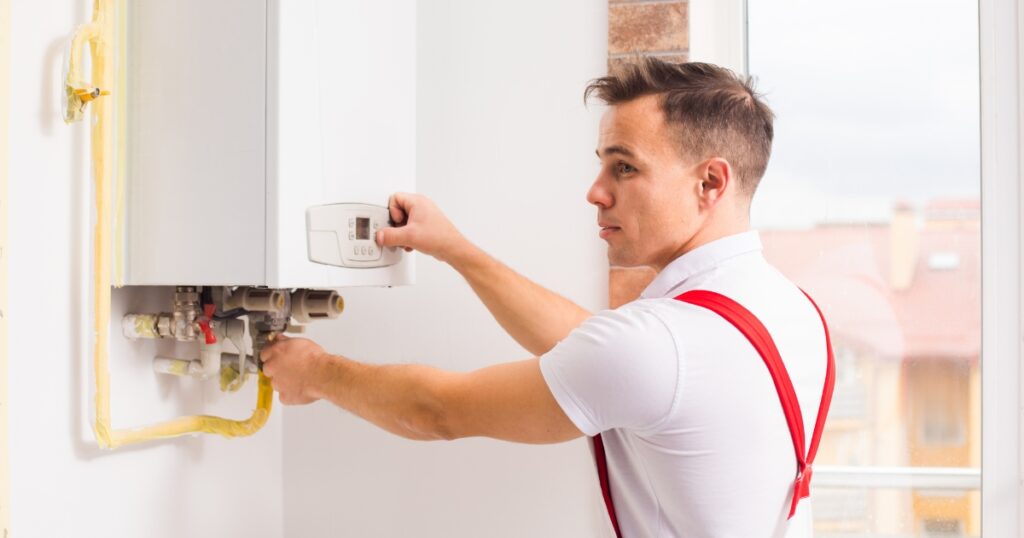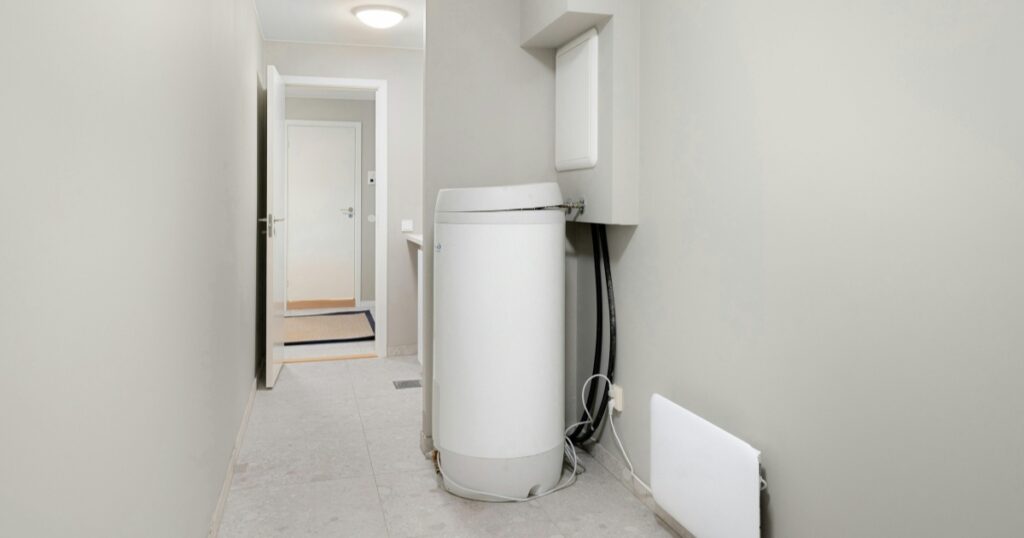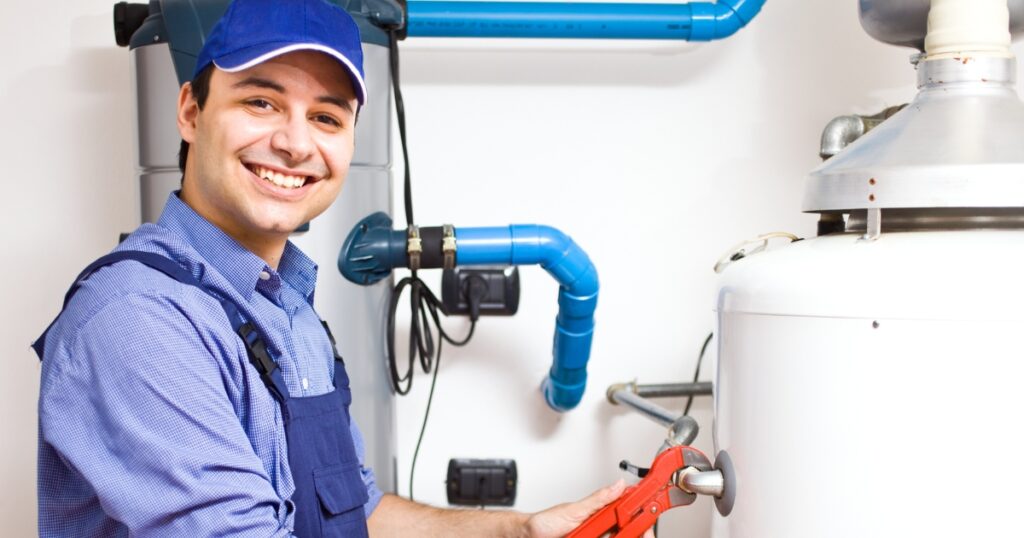Ever had a sudden, chilly surprise when your hot water system’s pilot light decided to take a hiatus? We know it’s an absolute bummer, especially when you’re racing against time. The silver lining? We’ve sussed out all the nitty-gritty of gas water heaters, with special attention on that pesky little component – the pilot light.
So grab a cuppa while we unravel the business of diagnosing and sorting out those stubborn pilot light issues in your hot water service unit. No more cold shocks – let’s crank up the warmth!
Key Takeaways
- The pilot light in a hot water system is crucial for igniting the main burner and ensuring proper heating.
- Common issues that can cause the pilot light to go out include a faulty thermocouple, environmental factors like strong breezes or dirty openings, blocked spud or gas supply, and failed parts.
- To relight the pilot light, locate the access cover, turn off the gas knob, wait for any remaining gas to dissipate, turn the knob to “pilot,” use a manual igniter or long match to ignite the flame, hold down the reset button or gas control valve for 30 seconds before releasing it.
- If troubleshooting doesn’t work or if there are other signs of trouble like rust damage or problems with the gas regulator, it’s best to call a professional plumber for hot water system repair.
Understanding the Pilot Light
The pilot light is a crucial component in various appliances, serving as the ignition source for the main burner. It can be found in water heaters, furnaces, boilers, and other gas-powered systems.
Location and function in different appliances
You’ll find the pilot light in several of your home appliances like water heaters, furnaces and some older-model gas stoves.

Its primary role involves igniting the main burner when you turn on the appliance.
Think of it as a small flame that’s always ready to go for immediate heat production. For instance, in water heaters, this tiny flame heats up a thermocouple — a safety device that monitors if your pilot light is burning effectively.
Should it be extinguished due to environmental factors or malfunctioning parts, the thermocouple promptly turns off the gas supply to prevent any hazardous leaks. Similarly, in furnaces and boilers too, these vigilant flames ensure quick heating while maintaining utmost safety at all times.
Reasons for Pilot Light Going Out
There are several reasons why a pilot light may go out, such as a faulty thermocouple, environmental factors like a strong breeze or dirty openings, blocked spud or gas supply, and failed parts.
Faulty thermocouple
If your pilot light keeps going out in your hot water system, a faulty thermocouple could be to blame. The thermocouple is an important component that detects the presence of the flame in the pilot light.
If it becomes bent or dirty, it can fail to function properly and cause the pilot light to go out repeatedly. In this case, you may need to replace the thermocouple to fix the issue.
Keep in mind that attempting repairs on your own should only be done if you have experience and knowledge in hot water system maintenance. Otherwise, it’s best to call a professional for assistance with repairing or replacing a faulty thermocouple.
Environmental factors (strong breeze, dirty openings, etc.)
Strong breeze or dirty openings around your hot water system can also affect the performance of the pilot light. These factors can disrupt the flame and cause it to go out unexpectedly.
It’s important to keep the area around your hot water system clean and clear of debris, while also taking measures to minimise any strong breezes that could blow out the flame. Regular maintenance and cleaning will help ensure that environmental factors don’t interfere with the proper functioning of your pilot light.
Blocked spud or gas supply
If your pilot light keeps going out in your hot water system, a possible reason could be a blocked spud or gas supply. A spud is a nozzle that allows gas to flow into the burner and ignite the pilot light.
Over time, debris or dirt can accumulate in the spud, blocking the gas supply and causing the pilot light to go out. To fix this issue, it is important to clean and clear any obstructions from the spud using compressed air or a small brush.
This will ensure proper gas flow and help keep your pilot light burning consistently without interruption. Remember, if you are unsure how to perform this task safely, it is always recommended to seek professional assistance for hot water system repair.
Failed parts
Sometimes, the pilot light in your hot water system may keep going out due to failed parts. This can include components like a faulty thermocouple or a broken thermostat. If the thermocouple is bent or dirty, it may not detect the flame properly and cause the pilot light to go out frequently.
Similarly, an old or malfunctioning thermostat can also lead to problems with the pilot light. It’s important to identify and replace any failed parts in order to ensure that your hot water system functions properly and consistently.

How to Relight the Pilot Light
To relight the pilot light, first, locate the access cover on your appliance and remove it. Then, turn the gas knob to the “off” position and wait a few minutes for any remaining gas to dissipate. Next, turn the gas knob to the “pilot” position and use a manual igniter or long match to ignite the pilot flame.
Once lit, hold down the reset button or gas control valve for about 30 seconds before releasing it.
Finally, carefully replace the access cover and ensure that everything is securely closed before testing your hot water system again.
Step-by-step process
To relight the pilot light in your hot water system, follow these simple steps. First, locate the access cover on the front of the water heater. Turn the knob to “off” and wait a few minutes for any remaining gas to dissipate.
Next, locate the pilot light assembly and ensure there is no accumulation of dirt or debris around it. If necessary, clean the area around the pilot light with a soft brush or cloth.
Once everything is clean, turn the knob to “pilot” and hold it down while using a long-reach lighter or match to ignite the pilot flame. Keep holding down the knob for about 30 seconds after ignition, then release it slowly.
Finally, if you are successful in lighting up your pilot light, turn on your gas supply by turning back on any shut-off valves you had turned off earlier.
Tips for relighting without a manual igniter
Relighting the pilot light in your hot water system can be a simple task, even without a manual igniter. Here are some tips to help you get it done smoothly:
1. Begin by turning the gas control knob to the “off” position and wait for a few minutes before proceeding.
2. Locate the access cover for the pilot light and remove it carefully using a screwdriver or wrench.
3. Once the cover is off, find the pilot light assembly and look for the thermocouple. Make sure it’s clean and free from any dirt or debris.
4. Use a long-stemmed lighter or fireplace match to ignite the flame at the pilot light assembly while holding down on the gas control knob.
Troubleshooting Pilot Light Issues for Water Heaters, Furnaces, Boilers
To troubleshoot pilot light issues in water heaters, furnaces, and boilers, start by checking for any obstructions or blockages in the gas supply or spud. Clean out any dirt or debris that may be causing a restriction.
Next, inspect the thermocouple for damage or wear. If bent or dirty, carefully clean it with a soft cloth and ensure it is properly aligned. If the thermocouple is damaged beyond repair, replace it with a new one.
Additionally, check for any issues with the gas regulator or flue venting system, as these can also cause problems with the pilot light. Always follow manufacturer instructions and safety precautions when troubleshooting and repairing hot water systems.
Common issues and how to fix them
If you’re experiencing issues with your hot water system’s pilot light, there are a few common problems that you can troubleshoot and fix yourself. One of the most frequent causes is a faulty thermocouple, which detects the flame in the pilot light.
To fix this issue, you’ll need to replace the thermocouple with a new one according to the manufacturer’s instructions. Another possible problem is a bent or dirty thermocouple, which can be fixed by cleaning or straightening it.
Additionally, if you suspect a gas regulator problem, it may require professional assistance to inspect and repair it. Finally, flue venting issues could also cause your pilot light to go out frequently.
When to Call a Professional for Hot Water System Repair
If you have tried troubleshooting your hot water system and are still experiencing issues with the pilot light, it may be time to call in a professional for help. A professional plumber or technician has the expertise to diagnose and fix more complex problems that could be causing the pilot light to go out.
They can also ensure that any repairs or maintenance tasks are done safely and efficiently, minimising the risk of further damage to your hot water system. Additionally, if you notice other signs of trouble such as rust damage or gas regulator problems, it is important to seek professional assistance right away.
Remember, calling a professional for hot water system repair can save you time, money, and frustration in the long run.
Have a Troubleshoot for Your Hot Water System
In conclusion, troubleshooting pilot light issues in a hot water system repair is crucial for maintaining a consistent and reliable source of hot water. By understanding the causes behind a pilot light going out and following the necessary steps to relight it, homeowners can often resolve these issues on their own.
However, if problems persist or if there are signs of more significant damage, it’s important to seek professional help to ensure proper repairs are made. Keep your hot water flowing smoothly by staying proactive with regular maintenance and prompt attention to any pilot light concerns.






